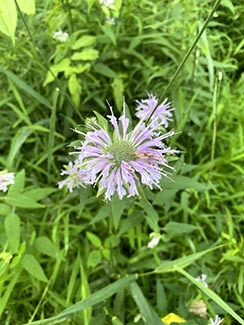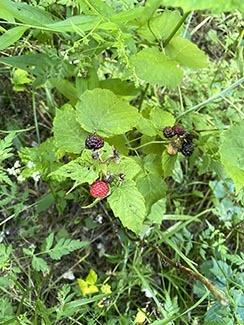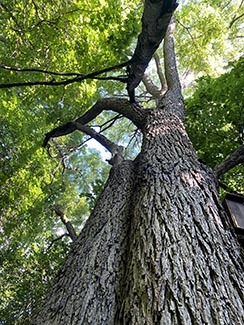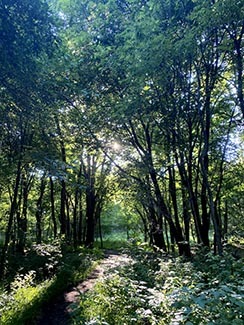With forest bathing, there’s no water required
By EMMA KUKUK
Michigan Department of Natural Resources
A wave of heat buffeted me as I stepped out of my car at a trailhead in the Rose Lake State Wildlife Area. It was a quiet summer day, the sound of passing cars distant and infrequent, gentle breezes dancing through tall grass while birds flitted between the trees.
The sun was bright and unobstructed by clouds, a gilded disk hanging in a cyan-blue sky. I felt a bead of sweat roll down my back and double-checked that I’d brought my water bottle.

Despite the heat, I was glad to be outside, to look at anything besides the blank wall behind my desk in my makeshift home office. Due to COVID-19, I’ve been working from home since March and haven’t really left my apartment except for necessities, and that isolation – no matter how necessary – was starting to get to me.
I needed to get out, to move, to get away from the daily stress and worry that now feel so overwhelming.
Usually, when I go out for hikes it’s to get some exercise or to spend time with a loved one. This time, I visited Rose Lake for another reason – to try out “forest bathing.” No, you don’t need a tub or even water. All you need is to be present in nature.
Unplug and unwind
Being in nature is something that comes, well, naturally to humans. Forest bathing, or shinrin-yoku, is a form of nature therapy that originated in Japan and has seen renewed interest in the past few years.
While the practice began in the 1980s, humanity’s need to be in and part of nature is far older. It’s an integral part of our species’ history, something rooted deep within each of us.
Nature can be a healing force. For centuries, we’ve recognized the powerful effect of reconnecting with the natural world. There is something rejuvenating about being out among the trees, in being surrounded by the sounds of the forest, the scent of wildflowers, the way sunlight plays through the leaves. Finding that revitalization is one of the key tenets of forest bathing.
“The art of forest bathing is the art of connecting with nature through our senses,” wrote Dr. Qing Li, the world’s foremost expert in forest medicine, in his book “Forest Bathing: How Trees Can Help You Find Health and Happiness.”
Li is vice president of the International Society of Nature and Forest Medicine, president of the Japanese Society of Forest Medicine and an associate professor at Nippon Medical School in Tokyo.
|

In his book, Li explores the science and history behind forest bathing and how best to practice it.
“The key to unlocking the power of the forest is in the five senses,” he wrote. “Let nature enter through your ears, eyes, nose, mouth, hands and feet.”
According to Li, there is no one way to forest bathe; many activities can achieve the intent of the practice. Yoga, foraging, tai chi, plant observations and even just walking out in the woods all can be considered part of forest bathing.
Thinking about this, I took a deep breath and started down the trail.
I realized very quickly that I was not very good at slowing down either my feet or my mind. I’d immediately defaulted to “hike mode,” walking briskly with my eyes trained on the path before me.
Then I stopped, taking a moment to re-center my awareness. Forest bathing is a lot like meditation. It takes concentration and intention.
At first, I found it difficult to focus on this aspect, to put my worries out of my mind, but gradually I began to relax. I slowed my pace, released the tension from my shoulders and really started to pay attention.
The dirt crunched under my shoes as I walked, my steps falling into a steady rhythm. The birds sang their own tunes, a discordant chorus, as the wind murmured through the leaves. A squirrel chattered somewhere out of sight, and a gentle creak echoed through the wood as a tree shifted beneath its own weight.
I’m no stranger to nature, but I couldn’t remember the last time I’d truly felt the earth so solidly beneath me, or when I’d felt the bone-deep awe and splendor of the natural world.
I’m sure I was subconsciously aware of those things before, but I hadn’t slowed down enough to really notice them. Nature had become something easy for me to tune out, something that fell away under the din of my thoughts. Despite being surrounded by it in my daily life, I had become distant from nature.
|

“Time spent in the forest is time that people should use to reconnect and get to know nature,” said Brenda Haskill, a Michigan Department of Natural Resources forest specialist. She’s been with the DNR for five years but has been around forests her entire life.
“When I’m out in the forest, it’s a place of comfort,” Haskill said. “I didn’t start to notice until I got older and really took the time to stop and slow myself down. I’m just more relaxed. My brain will start getting quieter. I think the same thing happens when people are around water.”
A lot of Michiganders know the feeling of looking out across a clear, tranquil lake and being instilled with a deep, soul-soothing calm. The forest was a different kind of serenity. Instead of placid quiet, the forest was its own world, an ever-shifting puzzle of color and light and sound, and I was a piece that fit perfectly within it.
I stopped and took a deep breath. It felt like the first breath after being underwater too long, the air sharp and clean.
Along the trail was a sea of green – tall grasses, the broad leaves of flowers and plants. Among the greenery was a smattering of color: a cluster of wild raspberries, a flourish of prairie fleabane and a splash of wild bee balm – and many more wild plants that I couldn’t identify but marveled at, nonetheless.
As I passed farther into the forest, I ran my hands over the gnarled bark of the trees, felt the rough ridges on my fingertips. I glanced down and saw the bright orange cap of a mushroom and gasped, delighted at the color.
So engrossed was I that I hadn’t once checked my phone for messages during my forest escape (though I did whip it out to take far too many photos for this article). It can be hard to put technology down, but there is so much more to see when you look away from the screen.
There is so much more to feel when you take a step back from your ordinary life to revel in the quiet of the forest. I felt far more at peace with myself and my life. I felt more solid, more present, after months lost to the depths of worldwide turmoil.
|

“In this time of chaos and uncertainty, forests offer us a model of harmony, efficiency and renewal that is currently in such short supply,” said Bill Sterrett, a district manager in the DNR’s Forest Resources Division. He’s worked to take care of Michigan’s state forests for 35 years, and currently oversees management of approximately a million acres of state forest land in the northwest Lower Peninsula.
“Trees are life givers. We, too, like the birds and animals, fundamentally rely on the forest,” Sterrett said.
Surrounded by the towering trees, I felt sheltered. Protected. There was something reassuring about seeing those thick trunks, knowing that these trees have lived longer than I have and seen the world through different times.
“There comes a point where nature becomes a safety net. The natural world has survived pandemics, catastrophes, epic destruction – nature rebuilds and resolves itself. There’s a feeling of safety in the tall trees around us, the big boulders holding the shoreline back,” Haskill said.
Nature can be an intimidating place, especially if you don’t have much experience with it. But it can also be a healing place. During this time of uncertainty, reconnecting with nature, for many, can be a simple yet powerful way to alleviate anxiety and restore some sense of order.
Soak in the sounds of Michigan nature
There are many ways to enjoy Michigan’s natural beauty. The DNR often says that you’re never more than a half-hour away from a state park, state forest or state trail system. With 103 state parks, 3.85 million acres of DNR-managed forest and over 13,000 miles of state-designated trails in Michigan, outdoor opportunities are all around us.
“The DNR manages one of the largest interconnected trail systems in the country,” said Paul Yauk, state trails coordinator for the DNR. “From long treks along the Iron Belle Trail to tranquil pathways in state forests to loops in state parks, there are plenty of opportunities to immerse yourself in nature.”
Many of those trails are accessible to people with disabilities. Since the beginning of the pandemic, people of all abilities have been using these resources at a far higher rate than usual.
|

“We’ve seen high levels of use on all trail types across Michigan, a great indication that as we continue to live in these unprecedented times it’s even more important that people have safe spaces where they can spread out and escape, refresh and reset,” said Dakota Hewlett, Iron Belle Trail coordinator for the DNR. “Trails are proving to be vital resources for the physical and mental health of many Michiganders.”
No matter how you embrace it, forest bathing is really whatever you want to make it. It can be a chance to unplug from your life for a little while, or a time to take your family someplace new. It can even be a learning opportunity.
“If you’re interested in butterflies, mushrooms, trees, berries – there are books and apps out there. There are tons of really fun things you can put on your phone that make getting out into nature even more fun,” said Haskill.
There are 20.3 million acres of forest in Michigan. The DNR manages about a fifth of that forest, with practices certified by both the Forest Stewardship Council and the Sustainable Forestry Initiative – two bodies that set standards for techniques to conserve soil, air and water quality, maintain wildlife and aquatic habitats and give us aesthetically pleasing places to enjoy the woods.
The DNR does its best to create healthy forests that will serve people, animals and the environment for generations to come. If you’re seeking a forest campground, hiking trail or state forest land near you, explore the DNR’s forest recreation map.
“If the forest is a new experience for you, start small, start local. Visit a local park and walk a well-marked trail. As you gain confidence, get off the trail a short distance and find a good location to sit or stand. If you want, bring something comfortable to sit on but don’t be afraid to sit on the forest floor,” Sterrett said. “Be still, be patient, and let it all sink in.”
Not everyone is comfortable going out into the woods, and that’s OK, too. Despite the name of the practice, you don’t need a forest to forest bathe. If you’re not able to get to a state park, forest or trail, you can still connect with nature.
|

Find whatever trees or greenery are most accessible to you – whether that’s your local city park, a nearby garden or even just your backyard.
“Look for a place where you can feel comfortable, somewhere that will fill your heart with joy,” wrote Li.
Nature is all around us, even if we don’t immediately see it. We just need to be pay attention. If you’re feeling stressed, anxious or overwhelmed, take a moment to yourself. Open your awareness to the world around you and soak in the sounds of nature.
“Listen to the birds sing and leaves rustle, feel the breeze on your face, smell the freshness and see all that comes into your field of vision,” said Sterrett. “Nature is a wonderful teacher and I believe it has a message more important and critical than ever in this day of uncertainty. You won’t hear it or read it, you need to go and feel it and observe it. Go seek it out; it is waiting patiently for you.”
No matter how you choose to engage with it, nature will always be there for you to explore.
|
Check out previous Showcasing the DNR stories in our archive at Michigan.gov/DNRStories. To subscribe to upcoming Showcasing articles, sign up for free email delivery at Michigan.gov/DNR.
/Note to editors: Contact: John Pepin, Showcasing the DNR series editor, 906-226-1352. Accompanying photos and a text-only version of this story are available below for download. Caption information follows. Credit Michigan Department of Natural Resources, unless otherwise noted.
Text-only Showcasing Story - Forest Bathing
Bee Balm: Wild bee balm grew along the trail, adding pops of color to the greenery.
Blackberries: Wild blackberries growing along the side of the trail at Rose Lake State Wildlife Area.
Canopy: A view of the treetops against the background of the sky.
Creek: Part of the trail crosses over Vermillion Creek, which winds through the Orange Unit of the wildlife area.
Maple: A towering maple near the trailhead.
Sun: A view of the sun filtered through the trees.
Trail: A shaded part of the trail in the western Orange Unit in Rose Lake State Wildlife Area./
|